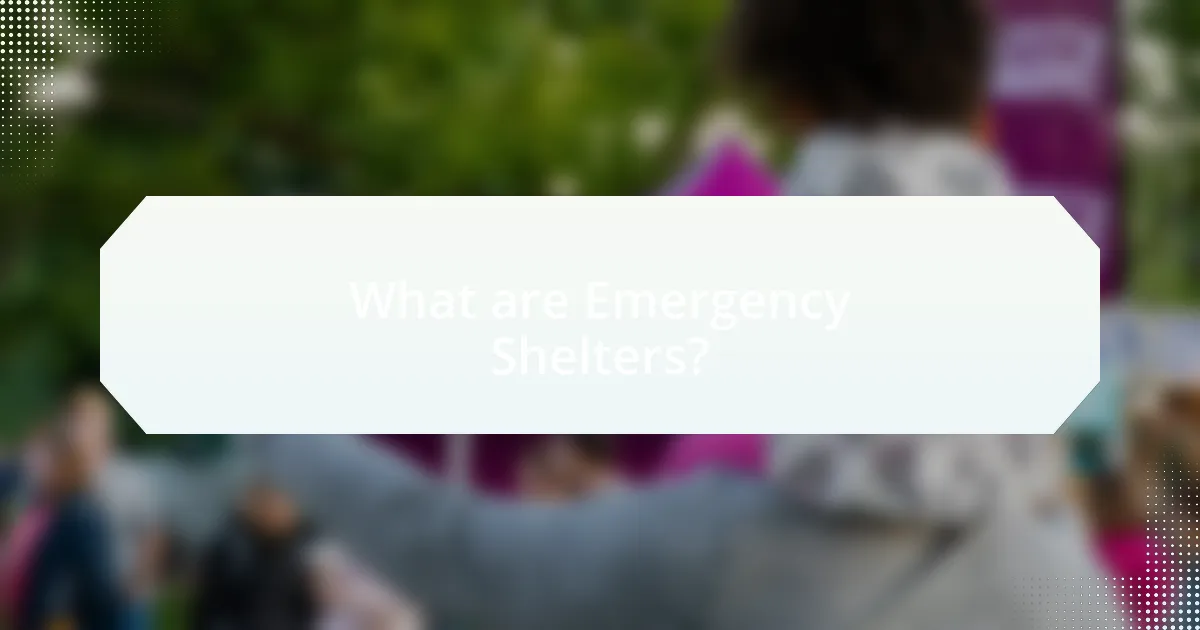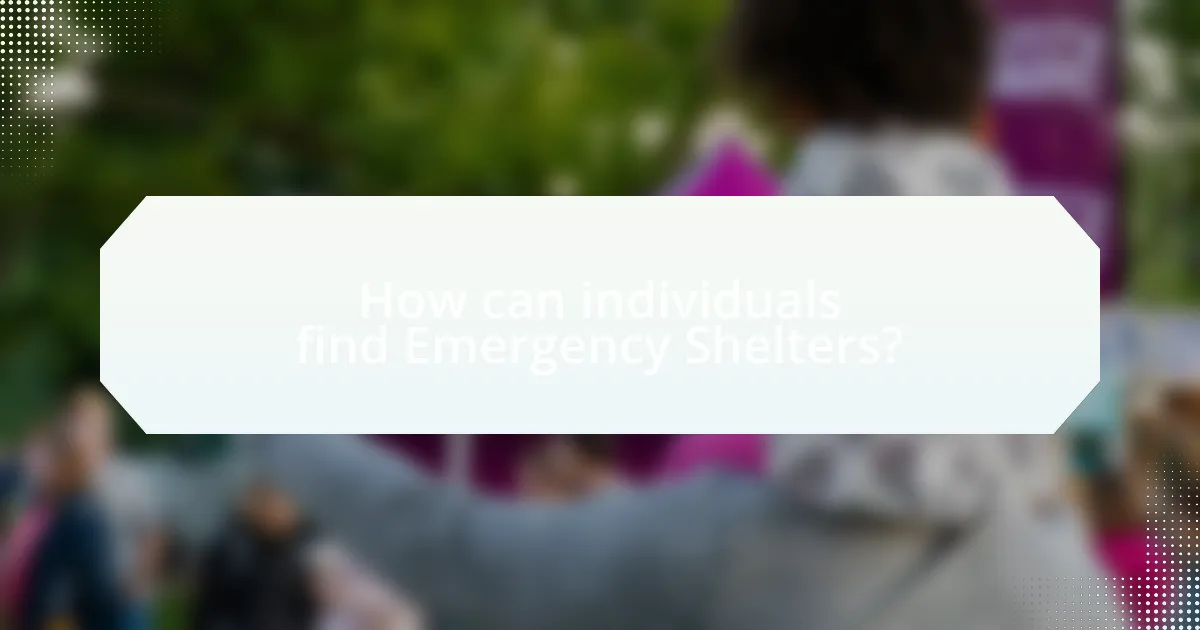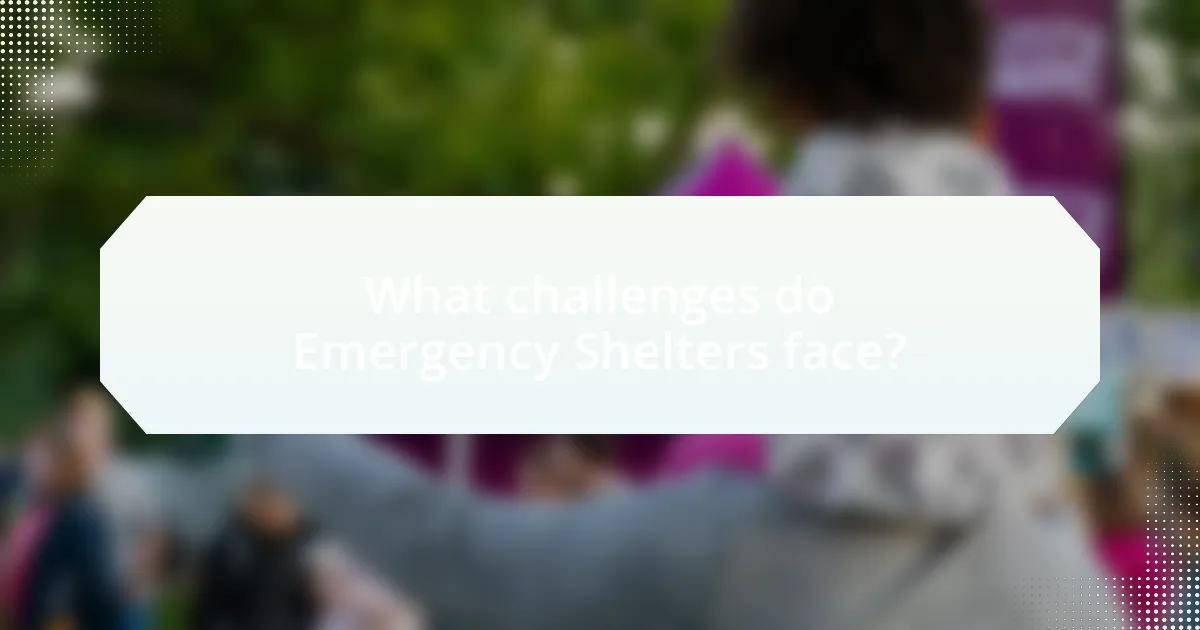Emergency shelters are temporary facilities that provide immediate housing and support services for individuals and families facing homelessness or crisis situations. These shelters offer essential resources such as food, bedding, and safety, while also connecting residents to longer-term housing solutions and social services. The article outlines the functions of emergency shelters, the types of services they provide, and their critical role in addressing homelessness and enhancing community health and safety. It also discusses the challenges shelters face, including funding limitations and staffing shortages, and offers practical steps for individuals seeking to access these vital resources.

What are Emergency Shelters?
Emergency shelters are temporary facilities that provide immediate housing and support services for individuals and families experiencing homelessness or crisis situations. These shelters typically offer basic necessities such as food, bedding, and safety, aiming to stabilize individuals and connect them with longer-term housing solutions. According to the National Alliance to End Homelessness, emergency shelters serve as a critical resource in addressing homelessness, providing a safe environment while facilitating access to social services and support networks.
How do Emergency Shelters function in providing immediate housing?
Emergency shelters provide immediate housing by offering temporary accommodations for individuals and families experiencing homelessness. These facilities typically operate on a first-come, first-served basis and are designed to quickly house those in crisis, often providing basic necessities such as food, hygiene facilities, and safety. According to the National Alliance to End Homelessness, emergency shelters serve as a critical intervention point, allowing individuals to stabilize their situation while accessing resources for longer-term housing solutions.
What types of services do Emergency Shelters offer to the homeless?
Emergency shelters offer a variety of essential services to the homeless, including temporary housing, meals, hygiene facilities, and access to social services. These shelters provide a safe environment where individuals can find immediate refuge from the elements and unsafe conditions. Additionally, many emergency shelters connect residents with resources such as job training, mental health support, and substance abuse counseling, which are crucial for long-term stability. According to the National Alliance to End Homelessness, emergency shelters play a vital role in the continuum of care by serving as a first step toward permanent housing solutions.
How do Emergency Shelters ensure safety and security for residents?
Emergency shelters ensure safety and security for residents through a combination of controlled access, trained staff, and safety protocols. Controlled access measures, such as secure entry points and identification checks, prevent unauthorized individuals from entering the facility, thereby protecting residents from potential harm. Trained staff members are present to monitor activities, provide assistance, and respond to emergencies, ensuring a safe environment. Additionally, safety protocols, including regular safety drills and emergency response plans, are implemented to prepare for various situations, further enhancing the security of the shelter. These measures collectively create a secure atmosphere for individuals seeking refuge.
Why are Emergency Shelters essential for addressing homelessness?
Emergency shelters are essential for addressing homelessness because they provide immediate, safe, and temporary housing for individuals and families in crisis. These shelters serve as a critical first step in the continuum of care, offering not only a place to sleep but also access to vital resources such as food, hygiene facilities, and support services. According to the National Alliance to End Homelessness, emergency shelters can significantly reduce the risk of exposure to violence and health issues associated with living on the streets, thereby improving overall well-being. Furthermore, they often connect residents with case management and housing assistance programs, facilitating the transition to permanent housing solutions.
What impact do Emergency Shelters have on community health and safety?
Emergency shelters significantly enhance community health and safety by providing immediate refuge for vulnerable populations, particularly during crises. These shelters reduce exposure to environmental hazards, violence, and health risks associated with homelessness, thereby improving overall public health outcomes. For instance, a study by the National Alliance to End Homelessness found that access to emergency shelters decreases the incidence of communicable diseases and mental health issues among homeless individuals. Furthermore, emergency shelters often serve as a gateway to additional services, such as healthcare and social support, which further contribute to community well-being and safety.
How do Emergency Shelters contribute to long-term housing solutions?
Emergency shelters contribute to long-term housing solutions by providing immediate safety and stability for individuals experiencing homelessness, which is a critical first step toward securing permanent housing. These shelters often connect residents with resources such as case management, job training, and mental health services, facilitating the transition to stable housing. For example, a study by the National Alliance to End Homelessness found that individuals who utilized emergency shelters were more likely to access supportive services that lead to permanent housing placements. This structured support system helps break the cycle of homelessness, demonstrating that emergency shelters play a vital role in the broader continuum of care aimed at achieving long-term housing stability.

How can individuals find Emergency Shelters?
Individuals can find emergency shelters by contacting local homeless service organizations, utilizing online resources, or calling helplines dedicated to homelessness assistance. Local organizations often maintain updated lists of available shelters and can provide immediate guidance. Websites such as the National Alliance to End Homelessness offer searchable databases for shelters by location. Additionally, the U.S. Department of Housing and Urban Development provides resources and links to local services. These methods ensure individuals can access timely information about available emergency housing options.
What resources are available for locating Emergency Shelters?
Emergency shelters can be located through various resources including local government websites, nonprofit organizations, and dedicated hotlines. Local government websites often provide updated lists of available shelters, while nonprofit organizations such as the Salvation Army and the Red Cross offer assistance and information on shelter locations. Additionally, the National Alliance to End Homelessness maintains a directory of resources that can help individuals find emergency shelters in their area. These resources are crucial for ensuring that those in need can access immediate housing solutions effectively.
How can technology assist in finding nearby Emergency Shelters?
Technology assists in finding nearby emergency shelters through mobile applications, GPS services, and online databases. Mobile apps like “Homeless Shelter Directory” and “211” provide real-time information on available shelters based on the user’s location. GPS services enable users to pinpoint the nearest shelters quickly, while online databases maintained by organizations such as the National Alliance to End Homelessness offer comprehensive listings of shelters, including their capacities and services. These technological tools enhance accessibility and efficiency in locating immediate housing solutions for the homeless.
What role do local organizations play in connecting individuals to Emergency Shelters?
Local organizations serve as crucial intermediaries in connecting individuals to emergency shelters. They provide essential resources such as information, referrals, and direct assistance to those in need. For instance, organizations like the Salvation Army and local homeless outreach programs often maintain updated databases of available shelters, ensuring that individuals can access timely and relevant options. Additionally, these organizations frequently collaborate with local governments and shelters to streamline the process of securing emergency housing, thereby enhancing the efficiency of service delivery. Their role is validated by studies indicating that community-based organizations significantly improve access to emergency services for vulnerable populations, demonstrating their effectiveness in addressing homelessness.
What factors should be considered when choosing an Emergency Shelter?
When choosing an emergency shelter, factors such as location, capacity, services offered, safety, and accessibility must be considered. The location should be convenient for individuals seeking shelter, ideally near public transportation and essential services. Capacity is crucial to ensure that the shelter can accommodate the number of individuals in need without overcrowding. Services offered, including meals, medical care, and counseling, enhance the support provided to residents. Safety is paramount; shelters should have security measures in place to protect residents. Lastly, accessibility for individuals with disabilities is essential to ensure that all individuals can receive the necessary support.
How do location and accessibility affect the choice of an Emergency Shelter?
Location and accessibility significantly influence the choice of an emergency shelter by determining how quickly and easily individuals can reach the shelter during a crisis. Proximity to public transportation, major roadways, and essential services like food and medical care enhances accessibility, making it more likely that those in need will utilize the shelter. For instance, a study by the National Alliance to End Homelessness indicates that shelters located near public transit hubs see higher occupancy rates, as individuals can access them without significant barriers. Additionally, shelters situated in safe neighborhoods with low crime rates are preferred, as safety concerns directly impact the willingness of individuals to seek refuge.
What amenities and services should one look for in an Emergency Shelter?
In an Emergency Shelter, one should look for essential amenities and services such as food provision, clean water access, sanitation facilities, medical assistance, and security. These amenities are critical for ensuring the health and safety of individuals seeking refuge. For instance, shelters that provide three meals a day and access to hygiene products significantly improve the well-being of residents. Additionally, the presence of medical staff or partnerships with local health services can address urgent health needs, while security measures ensure a safe environment. According to the National Alliance to End Homelessness, effective emergency shelters often include case management services to help individuals transition to permanent housing, further validating the importance of comprehensive support in these facilities.

What challenges do Emergency Shelters face?
Emergency shelters face several significant challenges, including limited resources, overcrowding, and the need for comprehensive support services. Limited resources often result in insufficient funding, which restricts the number of beds available and the quality of services provided. Overcrowding can lead to unsafe conditions and increased tension among residents, making it difficult to maintain a supportive environment. Additionally, the lack of comprehensive support services, such as mental health care and job training, hinders the ability of individuals to transition out of homelessness effectively. According to the National Alliance to End Homelessness, over 600,000 individuals experience homelessness on any given night in the United States, highlighting the urgent need for more effective solutions in emergency shelters.
How do funding and resource limitations impact Emergency Shelters?
Funding and resource limitations severely restrict the operational capacity of emergency shelters. These constraints lead to inadequate staffing, insufficient supplies, and limited services, which ultimately diminish the quality of care provided to individuals experiencing homelessness. For instance, a report from the National Alliance to End Homelessness indicates that shelters with reduced funding often struggle to maintain basic necessities such as food, hygiene products, and bedding, which are essential for the health and safety of residents. Additionally, limited financial resources can hinder shelters from offering supportive services like mental health counseling and job training, which are crucial for helping individuals transition out of homelessness.
What strategies can Emergency Shelters implement to overcome funding challenges?
Emergency shelters can implement diversified funding strategies to overcome financial challenges. These strategies include establishing partnerships with local businesses for sponsorships, applying for government grants specifically aimed at homelessness, and launching community fundraising campaigns to engage the public. For instance, the National Alliance to End Homelessness reports that shelters that actively seek multiple funding sources are more resilient during economic downturns. Additionally, shelters can enhance their visibility through social media and community outreach, which can lead to increased donations and volunteer support. By leveraging these strategies, emergency shelters can create a more sustainable funding model to support their operations.
How do staffing shortages affect the operation of Emergency Shelters?
Staffing shortages significantly hinder the operation of emergency shelters by limiting the availability of essential services and support for residents. When shelters lack adequate staff, they struggle to provide necessary assistance such as food distribution, health care, and emotional support, which are critical for the well-being of individuals experiencing homelessness. Research indicates that shelters operating with insufficient personnel often face increased wait times for services, reduced safety and security, and a decline in the overall quality of care provided. For instance, a study by the National Alliance to End Homelessness highlights that shelters with fewer staff members report higher instances of conflict among residents and lower satisfaction rates, ultimately affecting the shelter’s effectiveness in addressing homelessness.
What are the common misconceptions about Emergency Shelters?
Common misconceptions about emergency shelters include the belief that they are unsafe, overcrowded, and only for certain populations. Many people think emergency shelters are dangerous environments; however, most shelters are monitored and staffed by trained professionals to ensure safety. Additionally, the perception that shelters are always full is inaccurate; many shelters have the capacity to accommodate individuals and families in need. Lastly, some believe that only specific groups, such as the chronically homeless, can access these services, but emergency shelters are designed to assist anyone facing a housing crisis, regardless of their background.
Why do some people believe Emergency Shelters are unsafe?
Some people believe emergency shelters are unsafe due to concerns about violence, theft, and inadequate security measures. Reports indicate that individuals in shelters may face risks from other residents, leading to fears of physical harm or property loss. Additionally, the lack of privacy and overcrowding can exacerbate feelings of vulnerability, making some individuals hesitant to seek shelter. Studies have shown that these factors contribute to a perception of emergency shelters as unsafe environments, discouraging those in need from utilizing available resources.
How can public perception of Emergency Shelters be improved?
Public perception of emergency shelters can be improved through community engagement and education initiatives. By organizing open houses and informational sessions, shelters can demystify their operations and showcase the services they provide, fostering a sense of transparency. Research indicates that communities with active outreach programs report a 30% increase in positive perceptions of local shelters. Additionally, sharing success stories of individuals who have benefited from shelter services can humanize the experience and counteract negative stereotypes.
What practical steps can individuals take to access Emergency Shelters?
Individuals can access emergency shelters by first identifying local resources through community hotlines or websites that list available shelters. Many cities have dedicated services, such as the National Alliance to End Homelessness, which provides information on shelter locations and availability. Next, individuals should contact the shelters directly to inquire about bed availability, eligibility requirements, and any necessary documentation. Additionally, reaching out to local social services or non-profit organizations can provide guidance and assistance in navigating the shelter system. According to the U.S. Department of Housing and Urban Development, over 600,000 individuals experience homelessness on any given night, highlighting the importance of knowing how to access these critical resources.

Leave a Reply